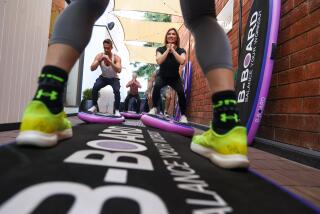We All Could Use More Balance in Our Lives
- Share via
Would you like to stop on a dime on the tennis court to hit that winning shot? Or enjoy in-line skating without so many falls? Or perhaps weave around opponents on the soccer field with greater ease?
We all would like to gain that extra edge to improve our game. Most of us know that cardiovascular conditioning, strength training and flexibility are the building blocks of any fitness program. But there’s another--often overlooked--aspect of fitness conditioning: balance training.
As the popularity of sport-specific training grows, balance training is getting more attention. The good news is that everyone has the ability to improve balance skills without having to go to the gym.
“Everything we do requires balance,” says Tara Denham, director of physical therapy at New York University’s Rusk Institute rehabilitation center. Balance, she explains, “is keeping your center of gravity within your base of support.”
Some of the training techniques used at the Rusk Institute were developed by NASA to help astronauts develop an unconscious sense of body positioning in the zero gravity of space. NASA scientists found that by making balance exercises a routine part of training, astronauts not only are more effective in space, but recover faster upon return to Earth.
Balance training techniques also can help us earthbound types in our regular daily activities, whether it’s stepping out of a sport utility vehicle wearing high heels, navigating a flight of stairs with several packages in hand or getting out of the bathtub as you reach for a towel.
*
As I entered the balance training laboratory at the Rusk Institute for the first time, I was surprised to see lots of children’s toys: balls, a jump rope, a trampoline. I thought to myself: This might be easier than I imagined.
Was I ever wrong about that.
My sessions included a challenging variety of exercises that tested my balance in both stationary positions and while moving. Each of the exercises required me to use my eyes, feet and inner ear, the latter of which controls our equilibrium.
First, Tara instructed me to jump on a trampoline while we tossed a ball back and forth between us. Next, I was asked to balance on a “wobble board,” a flat disk about 15 inches in diameter with a point on the bottom, and then to walk on a balance beam while holding a full cup of water.
Finally, the biggest challenge of all: a futuristic-looking machine called the Equitest that looked like something out of an amusement park. This device required me to stand on a fast-moving, three-sided platform that tilted and twisted me in a herky-jerky fashion. Using a toggle switch controlled with my feet, I tried to steer a tiny human figure into a little box displayed on a computer screen. Meanwhile, a timer showed me how well I was doing (not very) compared to astronauts and top athletes who had previously used the Equitest. After several minutes, dizzy and disoriented, I wanted off this torture test.
While my time was not exactly world-class, I was nevertheless convinced of the benefits of balance training.
*
Unless space travel is in your future plans, I suggest some down-to-earth exercises, none of which requires a gym membership. Add these exercises to your regular fitness program and you may be pleasantly surprised by the subtle changes you see.
These exercises fall into two categories, similar to the ones I experienced at NYU. One is “static” exercise, which refers to a held balance, such as standing on one leg. The other is “dynamic,” which is a moving balance, similar to a gymnast on a balance beam.
Static Balance Drills
* One-legged stance: Stand on one leg; keep your standing leg straight with that knee slightly bent. Lift the other leg about six inches off the floor, bending at the knee. Keep your hands by your side and close your eyes. See how long you can hold this pose.
* The Tree: In this yoga pose, stand tall with your arms by your sides and your weight evenly distributed on each foot. Slowly lift your left foot off the ground and place the sole of the foot along the inner thigh of your right leg. Place your hands together in front of your chest and slowly raise your arms overhead, palms together.
Dynamic Balance Drills
* Tightrope walking: Place a string or a piece of tape (about 8 feet long) in a straight line on the floor. Position yourself at one end of the tape. Hold a tennis ball in one hand. Walk along the line while tossing the tennis ball from one hand to the other without falling off the line.
* One-legged hopscotch: Balancing on one leg, hop forward four times. Then hop backward four times. Switch legs and repeat the exercise.
After several weeks of this training, I noticed that my balance improved dramatically. I began to breeze through much of what had been a challenging routine at the Rusk Institute.
Away from the university, I’ve also noticed an improved sense of balance when playing tennis, cycling or lifting weights. As for the Equitest, I’ve still got a long way to go. The competitor in me is determined to match the scores of those astronauts.
*
Stephanie Oakes is a New York-based fitness specialist and fitness editor for Discovery Health Channel. Her column runs on the fourth Monday of each month. She can be reached by e-mail at stephoakes@aol.com.

